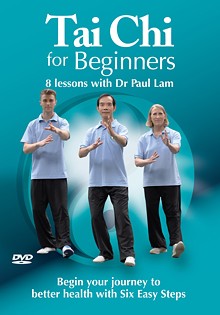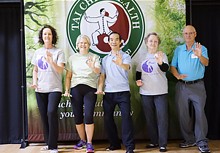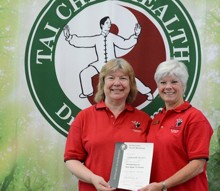Guide to Use the Tai Chi for Beginners DVD
| By: Dr Paul Lam |
| Copyright Dr Paul Lam 2005. Copying for non-profit educational purpose is permitted. For example, you may give your fee-paying students a copy of this article but not sell it to them.
Disclaimer: Persons involved in the writing of this article will not be held responsible in any way whatsoever for any injury or consequence that may arise as a result of following the instructions given in this article. Readers are advised to work with their health professionals before commencing these activities. Readers engaged in activities described in this article do so at their own risk. NB: After you have done this program, the next step would be the 24 Forms DVD, the book “Tai Chi for Beginners and the 24 Forms” would be very useful for progression. Introduction: Tai Chi for Beginners is based on the Six Easy Steps. These steps can be used by tai chi instructors as a class format. Follow the directions from the inside of your DVD cover or Page 8 of the handbook. Set aside a one-hour period at the same time and same day each week as though you are going to a class for your weekly lesson. Also schedule a half hour practice time most days. For learners please use the suggested lesson plan from the handbook. If you can only do a half hour lesson because of a time restraint or physical disability, then do one lesson in two sessions. If you find the lesson covers too much material for you, then do them with as many sessions as is comfortable for you. If you feel the lessons are too easy, try to refrain from learning faster than suggested. It’s not how fast you learn tai chi that matters. What counts is gaining health benefits and feeling the depth of tai chi. Actually, tai chi works better when a person progresses slowly. Be patient and take your time to learn and practice. Once you remember the movements, you can improve your posture, speed and quality of movement. Don’t advance to the next lesson until you’re proficient. If you have a medical condition that prevents you from doing the forms exactly as shown on the DVD, you can use visualization to keep progressing. The general rule: Move to what is well within your comfort zone and visualize whatever you can’t do. You can also adjust your level of exertion by not bending your knees too deeply, by using less internal force and lessening the length of time for practice. Do follow a routine to practice tai chi daily, this will help you adhere to regular practice. The best way to benefit and enjoy tai chi is to practice regularly. Whenever you feel you could be over-exerting yourself, use visualization to replace physical practice and check with your health professional at any time. Let us start: Congratulations! You’ve come this far. It gets more fun as you go. 1. Start with the introduction. It explains what tai chi is and suggests general precautions. Take care to follow the precautions.
7. Read “What’s Next?” in the handbook. Try to integrate each stage into your forms. Practice that stage for several weeks before moving on to the next. 8. When you feel proficient with the Tai Chi for Beginners set, you can continue to practice it and improve your level of tai chi through integrating the essential principles. Regular practice will bring you enjoyment and better health. 9. To continue your progression, consider finding a teacher with whom you “click.” Or you might attend one of Dr Lam’s workshops. Also, think of moving on to the “24 Forms” instructional DVD. A few points to consider: Review the tai chi principles regularly. As you progress in tai chi, they will take on a somewhat different meaning. Tai chi’s immense depth comes from its essential principles. You will find that the fundamental principles in tai chi are similar in most tai chi texts and might appear more simple than they are. To appreciate their depth, you must practice. Through practice, you can learn and enjoy the different layers of tai chi’s inner meanings. By now, you might need a suitable instructor to progress further and to help interpret these principles. Read my book Overcoming Arthritis, published by Dorley Kindersley, on how to find a good tai chi teacher. Or read the article on this topic in the Article section of my website. If you’re unable to find a suitable instructor or if you feel your progress might be much different from other members of a class, consider taking private lessons. Feel free to write to me for any advice. The best way to contact me is online through Ask Dr Lam.
Best wishes for a healthier and better quality of life. Enjoy the journey. |





